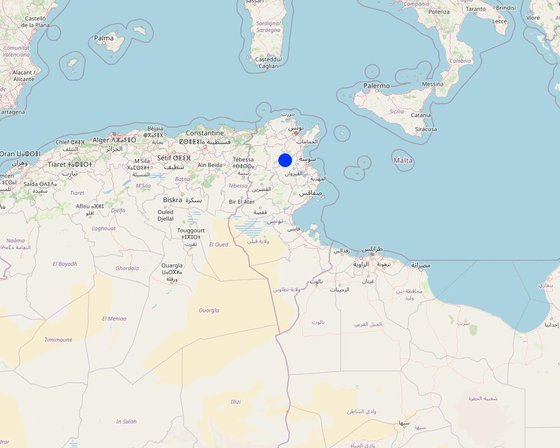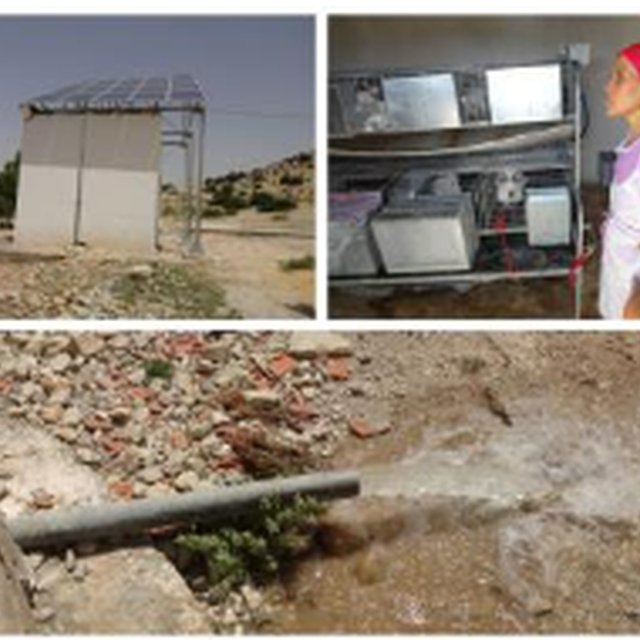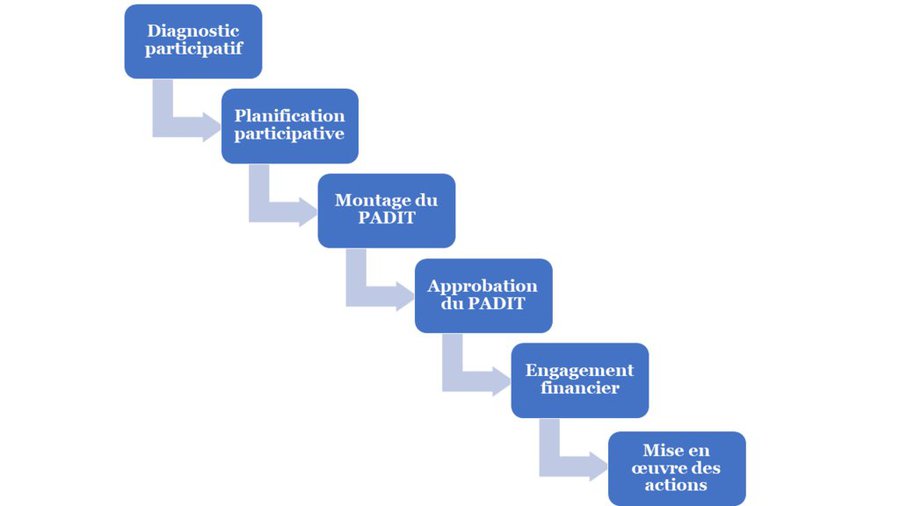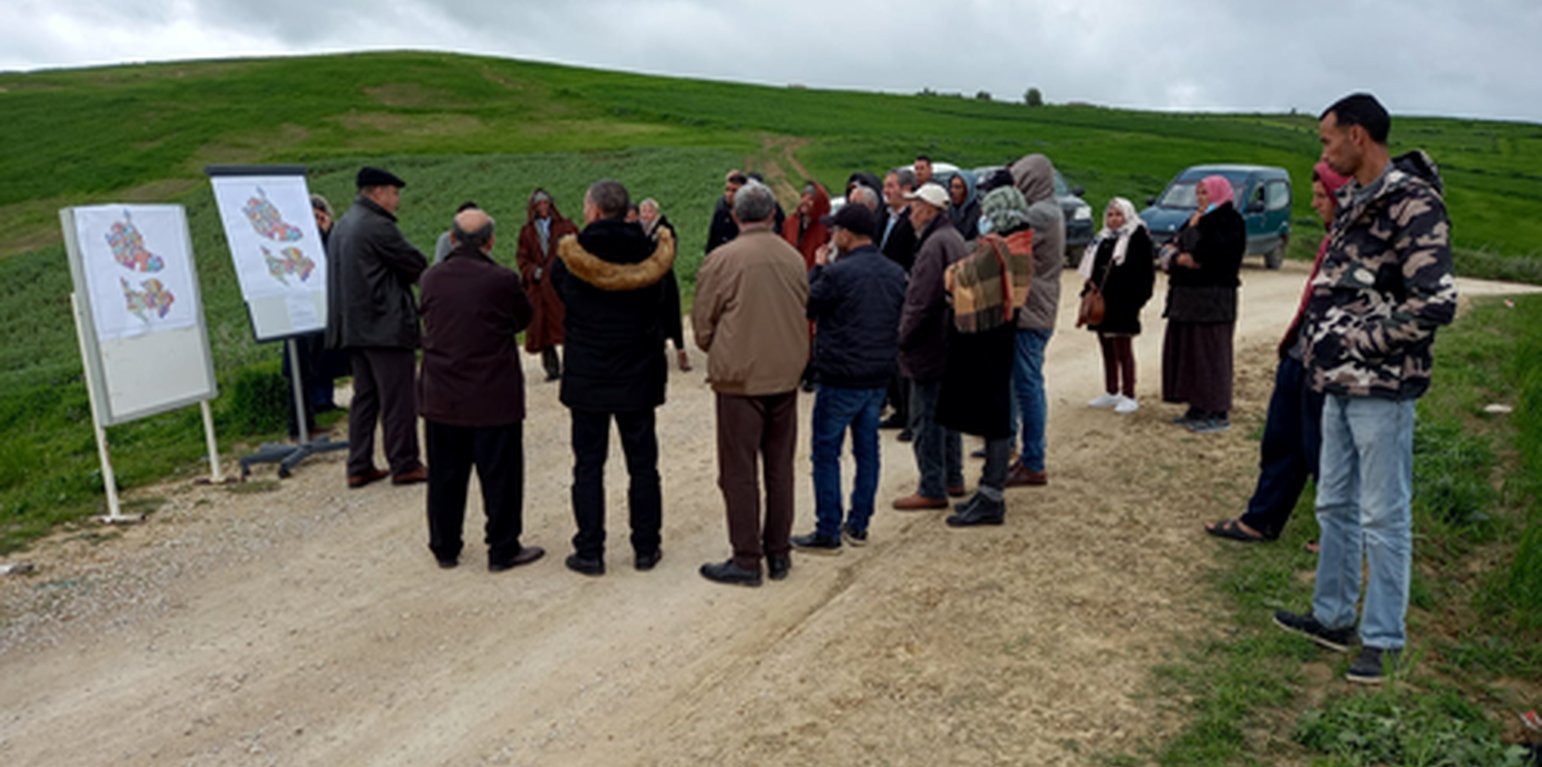Integrated Territorial Planning and Development Project (PADIT)
(Tunisia)
Description
The PADIT approach comprises a cross-cutting participatory methodology to rural development, rallying various stakeholders around a project, within a location, to identify the main economic areas of the rural community concerned, and draw up a prioritized list of actions to strengthen and support development efforts in their location.
The Directorate-General for the Development and Conservation of Agricultural Lands uses a cross-cutting participatory approach to rural development (Integrated Territorial Planning and Development Project or "PADIT"), rallying various stakeholders around a project, within a location (often a subsection of a municipality or imada), with the aim of identifying the main economic areas of the rural community concerned, and drawing up a prioritized list of actions to strengthen and support development efforts in their location. This approach aims to promote integrated rural development and sustainable management of natural resources.
The overarching aim is to establish and/or fortify the core economic activities that empower communities to maximize the assets and potential of their area. Simultaneously, the strategy endeavours to reinforce the connection between the population and their local environment.
Implementation stages:
1. Participatory diagnosis: This stage focuses on understanding the dynamics of the area, identifying strengths and weaknesses. The Rural Development Support Officer (CADR) plays a crucial role in organizing the population, delineating the intervention territory, identifying local potential, and fostering collaboration among the residents. This phase also encourages the emergence of rural development projects with a focus on soil and water conservation.
2. Participatory planning: This stage is based on collective feedback workshops to validate the diagnosis and collect action proposals from residents and regional experts.
3. Preparation of the PADIT: This stage translates the main concerns of rural communities into a programme of action and a financing plan. It outlines the individual and collective investments necessary to achieve social and economic objectives.
4. Approval of the PADIT: The PADIT is presented to local stakeholders for their approval.
5. Financial commitment: Various partners commit to financing the actions outlined in the PADIT (national budget, regional budget, additional funding from donors, etc.). This commitment is formalized through a Unitary Financial Programming Document (DOCUPF).
6. Implementation: This approach relies on active participation from the local community in the planning process, complemented by technical assistance from local, regional, and central government authorities. The Rural Development and Support Officer (CADR) is a well-trained technician responsible for coordinating activities within the territory and facilitating communication among various stakeholders.
Location

Location: Zaghdoud, Oueslatia, Kairouan, Tunisia
Geo-reference of selected sites
Initiation date: 2017
Year of termination: n.a.
Type of Approach
-
traditional/ indigenous
-
recent local initiative/ innovative
-
project/ programme based

Prioritizing the solution tree (Projet "Participation de la Population Locale à la Gestion des Ressources Naturelles en amont du barrage de Nebhana" [Project called "Participation of the Local Population in the Management of Natural Resources Upstream of the Nebhana Dam"]/DGACTA/GIZ)
Approach aims and enabling environment
Main aims / objectives of the approach
This new approach meets several objectives:
- Rational management of natural resources;
- Integrated, participatory development of rural areas;
- Involvement and empowerment of the population throughout the planning process.
Conditions enabling the implementation of the Technology/ ies applied under the Approach
-
Social/ cultural/ religious norms and values: The geographical area of intervention covers a portion of a municipality or imada
-
Availability/ access to financial resources and services: - This approach is implemented within the framework of a project.
- The signing of a single financial programming document (DOCUPF) is a commitment by the partners to finance the activities.
-
Institutional setting: Various entities and institutes are involved in this process.
-
Collaboration/ coordination of actors: Involvement of various stakeholders in natural resources management and agricultural development
at the central, regional and local levels.
-
Legal framework (land tenure, land and water use rights): Tunisia has adopted a new legal investment framework.
-
Policies: - Decentralization is a key component of projects
-
Land governance (decision-making, implementation and enforcement): Decentralization of government bodies and involvement of local and regional bodies in decision-making and implementation of the new economic and social development model.
-
Knowledge about SLM, access to technical support: The Rural Development Support Officers (CADR) play an important role in knowledge production and dissemination.
Conditions hindering the implementation of the Technology/ ies applied under the Approach
-
Legal framework (land tenure, land and water use rights): - Most agricultural lands need to be reorganized.
- The inapplicability of the Water and Soil Conservation (CES) Code (Act no. 95-70 of July 17, 1995).
Participation and roles of stakeholders involved
Stakeholders involved in the Approach and their roles
| What stakeholders / implementing bodies were involved in the Approach? |
Specify stakeholders |
Describe roles of stakeholders |
| local land users/ local communities |
The local population |
- Participation in territorial diagnosis.
- Proposal of actions including a CES component.
- Participation in the decision-making process.
- Participation in planning meetings. |
| community-based organizations |
- Local government |
- Participation in planning meetings.
- Participation in the decision-making process. |
| SLM specialists/ agricultural advisers |
-Rural Development Support Officer |
- Support for community/citizen organization.
- Rural development animation.
- Knowledge dissemination.
- Liaison between the administration, the territorial committee and the local population. |
| researchers |
Research institutions |
- Institutional and scientific support through expertise and innovation.
- Technical advice on proposed actions.
- Support for action proposals. |
| teachers/ school children/ students |
Teachers |
- Technical advice on proposed actions |
| NGO |
|
- Support for the local population.
- Support for decision-making. |
| private sector |
- Entrepreneur
- Company |
- Support for financing initiatives |
| local government |
|
- Participation in planning meetings.
- Participation in the decision-making process |
| national government (planners, decision-makers) |
Ministries (Finance, Agriculture, Development, etc.) |
- Participation in planning meetings.
- Participation in the decision-making process
- Participation in financing initiatives |
| international organization |
|
- Participation in financing.
- Institutional and scientific support. |
Involvement of local land users/ local communities in the different phases of the Approach
none
passive
external support
interactive
self-mobilization
initiation/ motivation
A series of meetings and interviews with the local population are held from the outset of the project, as part of the diagnosis of the area of intervention.
planning
The local population is involved in all phases of planning: proposing actions, prioritizing actions, locating actions, etc.
implementation
- Supporting the implementation of certain actions: selection of beneficiaries.
monitoring/ evaluation
Ownership of actions and participation in monitoring and evaluating their implementation
Flow chart
The implementation of the PADIT requires an understanding of the territory's assets and challenges during the diagnostic phase. Following the diagnosis, all stakeholders become involved in the planning process by proposing actions and geolocating them. The experts then set about drawing up the PADIT, assessing the feasibility of the proposed actions and estimating their cost. This document must be validated by the stakeholders before the partners make a commitment to finance it, in order to guarantee its implementation.

Author: Wafa SAIDI
Decision-making on the selection of SLM Technology
Decisions were taken by
-
land users alone (self-initiative)
-
mainly land users, supported by SLM specialists
-
all relevant actors, as part of a participatory approach
-
mainly SLM specialists, following consultation with land users
-
SLM specialists alone
-
politicians/ leaders
Decisions were made based on
-
evaluation of well-documented SLM knowledge (evidence-based decision-making)
-
research findings
-
personal experience and opinions (undocumented)
Technical support, capacity building, and knowledge management
The following activities or services have been part of the approach
-
Capacity building/ training
-
Advisory service
-
Institution strengthening (organizational development)
-
Monitoring and evaluation
-
Research
Capacity building/ training
Training was provided to the following stakeholders
-
land users
-
field staff/ advisers
Form of training
-
on-the-job
-
farmer-to-farmer
-
demonstration areas
-
public meetings
-
courses
Subjects covered
- Technical assistance and support for farmers and microproject beneficiaries.
- A two-day training course on participatory diagnosis methods and tools was organized for subject specialist technicians at national (DG-ACTA), regional and local levels (including CES, forestry, OEP, PV and CTV), community representatives, civil society and local authorities (OMDA).
- Training in facilitation and conflict management.
- Training on business plan preparation.
Advisory service
Advisory service was provided
-
on land users' fields
-
at permanent centres
Institution strengthening
Institutions have been strengthened / established
-
no
-
yes, a little
-
yes, moderately
-
yes, greatly
Describe institution, roles and responsibilities, members, etc.
CRDAs and CTVs
Type of support
-
financial
-
capacity building/ training
-
equipment
Further details
Capacity-building for CRDA and CTV staff (Rural Development Support Officer)
Monitoring and evaluation
Monitoring the implementation of the action plan involves three key mechanisms:
-Central monitoring of the action plan for new strategy implementation, which is overseen centrally
-Monitoring of CES action programs, which is conducted by the organization responsible for piloting the program. These action programs concern the PADITs carried out in prioritized zones, emergency works (such as one-off projects or the rehabilitation of existing structures posing a threat), works that have been rehabilitated before transfer to non-state managers, as well as activities related to animation, extension, training, and technical assistance
-Impact monitoring and evaluation
Research
Research treated the following topics
-
sociology
-
economics / marketing
-
ecology
-
technology
Development of applied research :
- on water and soil conservation, with demonstration plots
- to assess the micro-economic impact of SLM work on farms over the medium and long terms
Financing and external material support
Annual budget in USD for the SLM component
-
< 2,000
-
2,000-10,000
-
10,000-100,000
-
100,000-1,000,000
-
> 1,000,000
Precise annual budget: n.a.
DGACTA, OEP, "Participation of the Local Population in the Management of Natural Resources upstream of the Nebhana Dam" project
The following services or incentives have been provided to land users
-
Financial/ material support provided to land users
-
Subsidies for specific inputs
-
Credit
-
Other incentives or instruments
Financial/ material support provided to land users
partly financed
fully financed
equipment: machinery
25% for the purchase of tractors, combine harvesters and all types of towed and self-propelled equipment.
agricultural: seeds
Seeds are subsidized by OEP
agricultural: seeds: fertilizers
Fertilizers are subsidized by the DGPA
infrastructure: roads: schools
Labour by land users was
-
voluntary
-
food-for-work
-
paid in cash
-
rewarded with other material support
Impact analysis and concluding statements
Impacts of the Approach
No
Yes, little
Yes, moderately
Yes, greatly
Did the Approach empower local land users, improve stakeholder participation?
Land users and stakeholders are involved at every stage of the process.
Did the Approach enable evidence-based decision-making?
Concerted planning.
Did the Approach help land users to implement and maintain SLM Technologies?
Did the Approach improve coordination and cost-effective implementation of SLM?
Did the Approach mobilize/ improve access to financial resources for SLM implementation?
Involving the various stakeholders in the planning phase can facilitate access to financial resources.
A funding commitment document is signed by the partners.
Did the Approach improve knowledge and capacities of land users to implement SLM?
Meetings provide an opportunity to exchange information, and training sessions are organized.
Did the Approach improve knowledge and capacities of other stakeholders?
Participation in training sessions.
Did the Approach build/ strengthen institutions, collaboration between stakeholders?
Collaboration charter
Did the Approach mitigate conflicts?
Did the Approach empower socially and economically disadvantaged groups?
The intervention areas are socially and economically disadvantaged territories.
Did the Approach improve gender equality and empower women and girls?
Involving rural women in the planning process
Did the Approach encourage young people/ the next generation of land users to engage in SLM?
Did the Approach improve issues of land tenure/ user rights that hindered implementation of SLM Technologies?
Involvement of the Agricultural Land Agency
Did the Approach improve the capacity of the land users to adapt to climate changes/ extremes and mitigate climate related disasters?
Agroecology
Did the Approach lead to employment, income opportunities?
Main motivation of land users to implement SLM
-
increased production
-
increased profit(ability), improved cost-benefit-ratio
-
reduced land degradation
-
reduced risk of disasters
-
reduced workload
-
payments/ subsidies
-
rules and regulations (fines)/ enforcement
-
prestige, social pressure/ social cohesion
-
affiliation to movement/ project/ group/ networks
-
environmental consciousness
-
customs and beliefs, morals
-
enhanced SLM knowledge and skills
-
aesthetic improvement
-
conflict mitigation
Sustainability of Approach activities
Can the land users sustain what hat been implemented through the Approach (without external support)?
Benefits of training and technical assistance
Conclusions and lessons learnt
Strengths: land user's view
-
Participation in planning
Strengths: compiler’s or other key resource person’s view
-
Guarantees the sustainability of the technologies implemented
-
Technical and methodological capacity building
Weaknesses/ disadvantages/ risks: land user's viewhow to overcome
-
Limited finance
Donor involvement and commitment to financing more activities
Weaknesses/ disadvantages/ risks: compiler’s or other key resource person’s viewhow to overcome
-
Involvement of the public
Choosing a focus group that influences the majority of the population and works for the common good
References
Editors
-
Siagbé Golli
-
Faouzi Harrouchi
-
faouzi BATTI
-
Fatma Maaloul
-
Tabitha Nekesa
-
Ahmadou Gaye
Reviewer
-
William Critchley
-
Rima Mekdaschi Studer
Date of documentation: Dec. 7, 2022
Last update: May 1, 2024
Resource persons
-
Faouzi Harrouchi (harrouchi.fawzi@gmail.com) - SLM specialist
-
faouzi BATTI (batti.faouzi@yahoo.es) - SLM specialist
-
Fatma Maaloul (maaloulfa@gmail.com) - SLM specialist
Full description in the WOCAT database
Documentation was faciliated by
Institution
- Direction Générale de l’Amenagement et de Conservation des Terres Agricoles (DG/ACTA) - Tunisia
- GIZ Tunisia (GIZ Tunisia) - Tunisia
Project
- Soil protection and rehabilitation for food security (ProSo(i)l)
Key references
-
Stratégie pour l’Aménagement et la Conservation des Terres Agricoles (ACTA) à l’horizon 2050, Direction Générale d'Aménagement et de Conservation des Terres Agricoles, 2017: Ministry of Agriculture, Directorate-General for the Development and Conservation of Agricultural Lands
-
Rapport Plan participatif de gestion des eaux et des sols , Projet « Participation de la population locale à la gestion des ressources naturelles en amont du système hydraulique Nebhana», La Zone Zaghdoud-Oueslatia - Kairouan,2018: Ministry of Agriculture, Directorate-General for the Development and Conservation of Agricultural Lands
-
Guide des procédures du PADIT, AFC Agriculture and Finance Consultants GmbH (AFC), 2023: Ministry of Agriculture, Directorate-General for the Development and Conservation of Agricultural Lands






